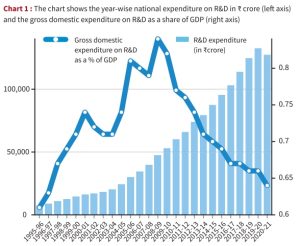India’s Research and Development expenditure
Problems with R & D expenditure:
- Low Overall Investment: India’s R&D expenditure as a percentage of GDP is relatively low compared to other countries. In the recent past, India’s research and development (R&D) expenditure has dropped to the current 0.64% of GDP from 0.8% in 2008-2009 and 0.7% in 2017-2018, while most developed countries spend between 2% to 4% of their respective GDPs.

- Dependence on Public Funding: The bulk of R&D funding in India comes from government sources, indicating a lack of private sector participation. Over reliance on public funding limits the diversity of research initiatives and innovation, as private sector investment often focuses on commercially viable projects.
- In 2020-2021, the private sector industry contributed 36.4% of the GERD whereas the Union government’s share was 43.7%. State governments (6.7%), higher education (8.8%), and the public sector industry (4.4%) were the other major contributors.
- Underutilization of Budget: In 2022-2023, the Department of Biotechnology (DBT) used 72% of its estimated budget allocation on centrally sponsored schemes/projects while the Department of Science and Technology (DST) used only 61%. This underutilization reflects inefficiencies in planning, execution, and monitoring of R&D projects, leading to wasted resources and missed opportunities for scientific advancement.
- Bureaucratic Hurdles: Cumbersome bureaucratic processes within government agencies delay grant disbursements, project approvals, and overall implementation of R&D initiatives. These bureaucratic hurdles discourage researchers and organisations from engaging in R&D activities and contribute to inefficiencies in the system.
- Lack of Coordination and Strategic Planning: There is often a lack of coordination between different government departments and agencies involved in R&D, leading to duplication of efforts and fragmented initiatives. Additionally, there’s a need for better strategic planning to align R&D investments with national development goals and emerging challenges.
Solutions to address the problems in R & D expenditure:
- Increase Public Investment: The government needs to prioritise R&D funding and allocate a higher percentage of the budget towards it. The target of 2% GDP for R&D spending, as outlined in the Science, Technology and Innovation policy and different economic surveys, should be pursued vigorously
- Encourage Private Sector Participation: India should create a conducive environment for private sector investment in R&D. This could involve offering tax incentives, streamlining regulatory processes, and ensuring protection of intellectual property rights.
- Establish Clear Regulatory Framework: Ambiguities in regulatory processes can deter private investment in R&D. India should work on creating clear and predictable regulatory frameworks to boost investor confidence.
- Capacity Building: Strengthening bureaucratic capacity within government agencies is crucial for efficient evaluation, allocation, and monitoring of R&D funds. This includes streamlining processes for grant disbursements and ensuring timely execution of projects.
- Implement Anusandhan National Research Foundation: The delay in implementing the Anusandhan National Research Foundation needs to be addressed, and the remaining budget from private sources should be raised as planned. This foundation could potentially address some of the financial challenges in R&D.
- Enhance Budget Utilisation: Efforts should be made to improve the utilisation of allocated R&D funds. This requires effective planning, implementation strategies, and monitoring mechanisms to ensure optimal utilisation of resources.
- Political Will and Prioritization: There needs to be a strong political will to prioritise R&D spending as a critical driver of India’s development journey. This prioritisation should be reflected not only within science and technology ministries but also in the Ministry of Finance.
- Incentivize Foreign Direct Investment (FDI): Relaxation of FDI norms in R&D-intensive sectors can attract foreign investment and technological expertise, contributing to India’s R&D ecosystem.
Implementing these measures, can help India to achieve sustainable funding for science and technology, thereby accelerating its journey towards becoming a science power by 2047.
Subscribe
Login
0 Comments
